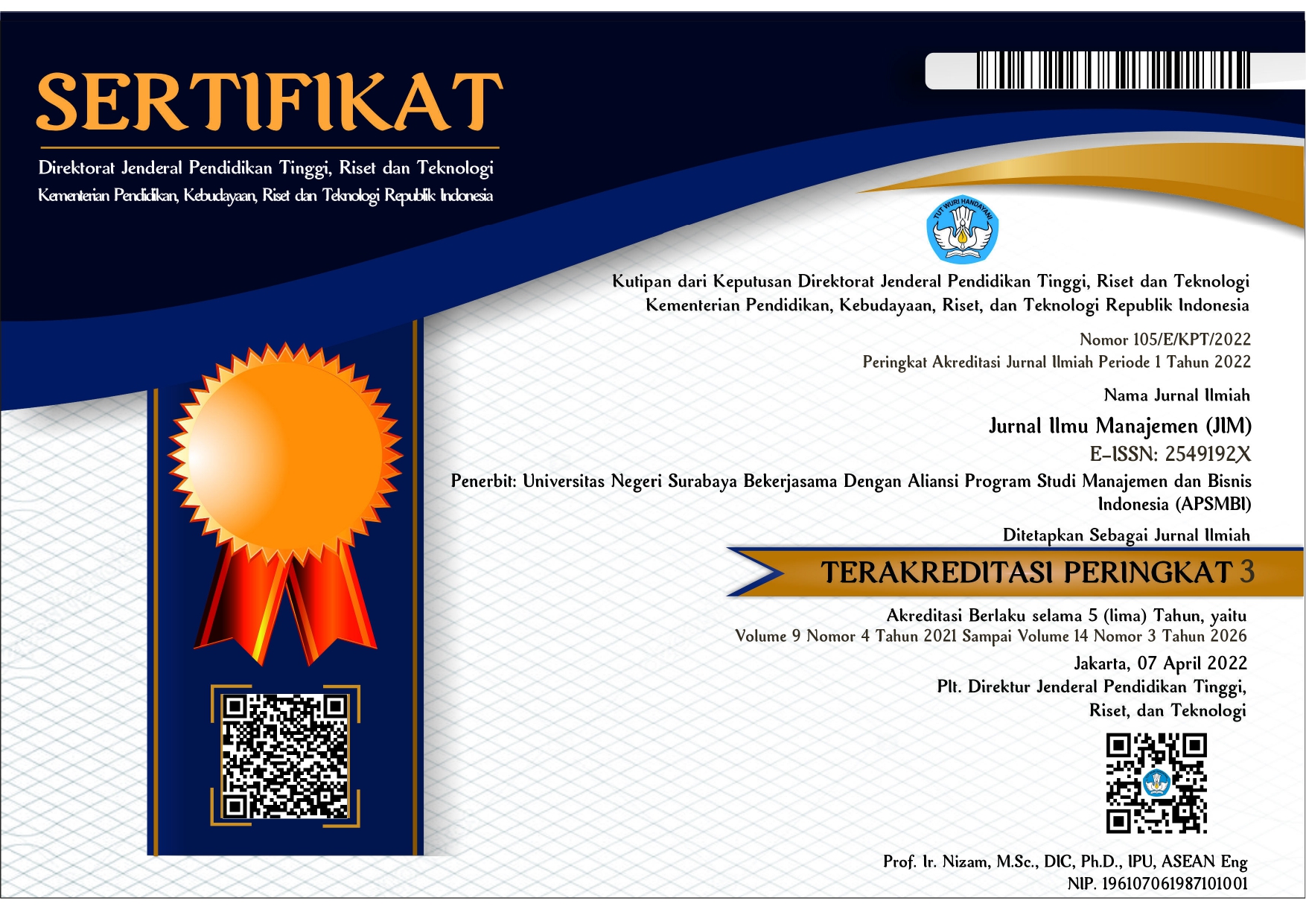Membangun brand image melalui penggunaan Augmented Reality: meningkatkan purchase intention dengan teknologi canggih
DOI:
https://doi.org/10.26740/jim.v13n1.p64-78Keywords:
augmented reality, brand image, interactivity, purchase intention, vividnessAbstract
This research aims to optimise the role of Augmented Reality (AR) by investigating how interactivity and vividness influence brand image and consumer purchase intention. Adopting a quantitative approach, data were gathered through an online questionnaire distributed to 130 respondents selected via purposive sampling, based on age classifications aligned with digital consumption trends from Katadata.id. The constructs were measured using a 5-point Likert scale and analysed using Partial Least Squares-Structural Equation Modelling (PLS-SEM) with SmartPLS software, which is well-suited for evaluating complex relationships in small to medium-sized samples. The findings indicate that vividness significantly influences purchase intention and positively affects brand image. Additionally, purchase intention is found to have a strong impact on brand image. The novelty of this study lies in its application of AR technology to explore its perceptual impact on branding, highlighting the pivotal role of visual interactivity. These insights underscore the importance of incorporating vivid and interactive AR features in digital marketing strategies. The research contributes to the growing literature on immersive technologies in consumer behaviour and offers practical implications for e-commerce firms aiming to enhance brand perception and drive conversions in a competitive digital marketplace.
References
Ahdiat, A. (2024). E-commerce dengan Pengunjung Terbanyak Sepanjang 2023. Databoks. https://databoks.katadata.co.id/datapublish/2024/01/10/5-e-commerce-dengan-pengunjung-terbanyak-sepanjang-2023
Arindaputri, N. B., & Santoso, S. (2023). Analysis of the influence of digital marketing, brand image, and price perception on purchase intention and brand loyalty in Uniqlo apparel products. International Journal of Research in Business and Social Science, 12(4), 57–65. https://doi.org/10.20525/ijrbs.v12i4.2612
Babin, L. A., & Burns, A. C. (1998). A modified scale for the measurement of communication-evoked mental imagery. Psychology and Marketing, 15(3), 261–278. https://doi.org/10.1002/(SICI)1520-6793(199805)15:3<261::AID-MAR4>3.0.CO;2-8
Barreda, A. A., Nusair, K., Wang, Y., Okumus, F., & Bilgihan, A. (2020). The impact of social media activities on brand image and emotional attachment: A case in the travel context. Journal of Hospitality and Tourism Technology, 11(1), 109–135. https://doi.org/10.1108/JHTT-02-2018-0016
Barta, S., Gurrea, R., & Flavián, C. (2023). Using a reality to reduce cognitive dissonance and increase purchase intention. Computers in Human Behavior, 140(1), 1–13. https://doi.org/10.1016/j.chb.2022.107564
Bayu, D. (2022). Riset: Milenial Paling Banyak Belanja di E-commerce pada 2021. DataIndonesia.Id. https://dataindonesia.id/ekonomi-digital/detail/survei-milenial-paling-banyak-belanja-di-ecommerce-pada-2021
Bozkurt, S., Gligor, D., Ozer, S., Sarp, S., & Srivastava, R. (2023). The impact of perceived social media interactivity on brand trust. The mediating role of perceived social media agility and the moderating role of brand value. Journal of Marketing Analytics, 12(3), 523–536. https://doi/org/ 10.1057/s41270-023-00268-w
Butt, A., Ahmad, H., Muzaffar, A., Ali, F., & Shafique, N. (2022). WOW, the make-up AR app is impressive: a comparative study between China and South Korea. Journal of Services Marketing, 36(1), 73–88. https://doi.org/10.1108/JSM-12-2020-0508
Chong, A. Y. L., Lacka, E., Boying, L., & Chan, H. K. (2018). The role of social media in enhancing guanxi and perceived effectiveness of E-commerce institutional mechanisms in online marketplace. Information and Management, 55(5), 621–632. https://doi.org/10.1016/j.im.2018.01.003
Dacko, S. (2017). Enabling Smart Retail Settings via Mobile Augmented Reality Shopping Apps. Technological Forecasting and Social Change, 124(1), 243–256. https://doi.org/https://doi.org/10.1016/j.techfore.2016.09.032
Erdmann, A., Mas, J. M., & Arilla, R. (2023). Value-based adoption of augmented reality: A study on the influence on online purchase intention in retail. Journal of Consumer Behaviour, 22(4), 912–932. https://doi.org/https://doi.org/10.1002/cb.1993
Fortin, D. R., & Dholakia, R. R. (2005). Interactivity and vividness effects on social presence and involvement with a web-based advertisement. Journal of Business Research, 58(3), 387–396. https://doi.org/10.1016/S0148-2963(03)00106-1
Garbarino, E. C., & Edell, J. A. (1997). Cognitive effort, affect, and choice. Journal of Consumer Research, 24(2), 147–158. https://doi.org/10.1086/209500
Hair, J., Black, W. C., Babin, B. J., & Anderson, R. E. (2006). Multivariate Data Analysis 7th (Ed.7). Pearson Prentice Hall.
Hassouneh, D., & Brengman, M. (2011). Virtual worlds: A gateway for SMEs toward internationalization. Journal of Brand Management, 19(1), 72–90. https://doi.org/10.1057/bm.2011.24
Hausman, A. V., & Siekpe, J. S. (2009). The effect of web interface features on consumer online purchase intentions. Journal of Business Research, 62(1), 5–13. https://doi.org/10.1016/j.jbusres.2008.01.018
Hilken, T., de Ruyter, K., Chylinski, M., Mahr, D., & Keeling, D. I. (2017). Augmenting the eye of the beholder: exploring the strategic potential of augmented reality to enhance online service experiences. Journal of the Academy of Marketing Science, 45(6), 884–905. https://doi.org/10.1007/s11747-017-0541-x
Hsu, S. H. Y., Tsou, H. T., & Chen, J. S. (2021). “Yes, we do. Why not use augmented reality?” customer responses to experiential presentations of AR-based applications. Journal of Retailing and Consumer Services, 62(1), 1–12. https://doi.org/10.1016/j.jretconser.2021.102649
Huang, R., Geng, Z., & Siraj, I. (2022). Exploring the Associations among Chinese Kindergartners between Academic Achievement and Behavioral, Cognitive and Emotional Self-Regulation. Early Education and Development, 34(3), 591–606. https://doi.org/10.1080/10409289.2022.2056695
Huang, T.-L., Mathews, S., & Chou, C. Y. (2019). Enhancing online rapport experience via augmented reality try-on service systems. Journal of Services Marketing, 33(7), 851–865. https://doi.org/10.1108/JSM-12-2018-0366
Javornik, A. (2016). Augmented reality: Research agenda for studying the impact of its media characteristics on consumer behaviour. Journal of Retailing and Consumer Services, 30(1), 252–261. https://doi.org/10.1016/j.jretconser.2016.02.004
Jia, X., Alvi, A. K., Nadeem, M. A., Akhtar, N., & Zaman, H. M. F. (2022). Impact of Perceived Influence, Virtual Interactivity on Consumer Purchase Intentions Through the Path of Brand Image and Brand Expected Value. Frontiers in Psychology, 13(1), 1–13. https://doi.org/10.3389/fpsyg.2022.947916
Keller, K. L. (2010). Brand equity management in a multichannel, multimedia retail environment. Journal of Interactive Marketing, 24(2), 58–70. https://doi.org/10.1016/j.intmar.2010.03.001
Kim, D., Park, S. P., & Yi, S. (2021). Relevant and rich interactivity under uncertainty: Guest reviews, host responses, and guest purchase intention on Airbnb. Telematics and Informatics, 65(1), 1–10. https://doi.org/10.1016/j.tele.2021.101708
Kim, J.-H., Minjeong, K., Mingjung, P., & Jungmin, Y. (2021). How interactivity and vividness influence consumer virtual reality shopping experience: the mediating role of telepresence. Journal of Research in Interactive Marketing, 15(3), 502–525. https://doi.org/https://doi.org/10.1108/JRIM-07-2020-0148
Kim, K. H., Ko, E., Kim, S. J., & Jiang, Q. (2021). Digital service innovation, customer engagement, and customer equity in AR marketing. Journal of Global Scholars of Marketing Science: Bridging Asia and the World, 31(3), 453–466. https://doi.org/10.1080/21639159.2021.1923054
Kim, S., Baek, T. H., & Yoon, S. (2020). The effect of 360-degree rotatable product images on purchase intention. Journal of Retailing and Consumer Services, 55(1), 1–10. https://doi.org/10.1016/j.jretconser.2020.102062
Kim, T. H., & Choo, H. J. (2021). Augmented reality as a product presentation tool: focusing on the role of product information and presence in AR. Fashion and Textiles, 8(29), 1–23. https://doi.org/10.1186/s40691-021-00261-w
Kim, T. H., & Im, H. (2023). Can augmented reality impact your self-perceptions? The malleability of the self and brand relationships in augmented reality try-on services. Journal of Consumer Behaviour, 23(4), 1623–1637. https://doi.org/https://doi.org/10.1002/cb.2296
Kumar, H., & Srivastava, R. (2022). Exploring the role of augmented reality in online impulse behaviour. International Journal of Retail and Distribution Management, 50(10), 1281–1301. https://doi.org/10.1108/IJRDM-11-2021-0535
Liu, C., Zhang, Y., & Zhang, J. (2020). The impact of self-congruity and virtual interactivity on online celebrity brand equity and fans’ purchase intention. Journal of Product and Brand Management, 29(6), 783–801. https://doi.org/10.1108/JPBM-11-2018-2106
Ma, A. K. F., Liao, W., & Liu, Z. (2022). The Future of e-commerce: Live Stream Shopping and Purchase Intention Post-COVID-19. International Journal of Electronic Commerce Studies, 13(3), 147–184. https://doi.org/10.7903/ijecs.2129
McClure, C., & Seock, Y. K. (2020). The role of involvement: Investigating the effect of brand’s social media pages on consumer purchase intention. Journal of Retailing and Consumer Services, 53(1), 1–8. https://doi.org/10.1016/j.jretconser.2019.101975
McLean, G., & Wilson, A. (2019). Shopping in the digital world: Examining customer brand engagement through augmented reality mobile applications. Computers in Human Behavior, 101(1), 1–15. https://doi.org/10.1016/j.chb.2019.07.002
McMillan, K., Flood, K., & Glaeser, R. (2017). Virtual reality, augmented reality, mixed reality, and the marine conservation movement. Aquatic Conservation: Marine and Freshwater Ecosystems, 27(2), 162–168. https://doi.org/10.1002/aqc.2820
Miyatake, K., Nemoto, T., Nakaharai, S., & Hayashi, K. (2016). Reduction in Consumers’ Purchasing Cost by Online Shopping. Transportation Research Procedia, 12(1), 656–666. https://doi.org/10.1016/j.trpro.2016.02.019
Nikhashemi, S. R., Knight, H. H., Nusair, K., & Liat, C. B. (2021). Augmented reality in smart retailing: A (n) (A) Symmetric Approach to continuous intention to use retail brands’ mobile AR apps. Journal of Retailing and Consumer Services, 60(1), 1–21. https://doi.org/10.1016/j.jretconser.2021.102464
Nisbett, R. E., & Ross, L. (1980). Human inference: Strategies and shortcomings of social judgment. Prentice Hall.
Papagiannis, H. (2020). How AR Is Redefining Retail in the Pandemic. Harvard Business Review. https://hbr.org/2020/10/how-ar-is-redefining-retail-in-the-pandemic
Peña-García, N., Gil-Saura, I., Rodríguez-Orejuela, A., & Siqueira-Junior, J. R. (2020). Purchase intention and purchase behavior online: A cross-cultural approach. Heliyon, 6(6), 1–11. https://doi.org/10.1016/j.heliyon.2020.e04284
Plotkina, D., Dinsmore, J., & Racat, M. (2022). Improving service brand personality with augmented reality marketing. Journal of Services Marketing, 36(6), 781–799. https://doi.org/10.1108/JSM-12-2020-0519
Prabowo, H., Astuti, W., & Respati, H. (2020). Effect of Service Quality and Brand Image on Repurchase Intention through Word of Mouth at Budget Hotels Airy Rooms. Open Journal of Business and Management, 8(1), 194–207. https://doi.org/10.4236/ojbm.2020.81012
Rauschnabel, P. A., Felix, R., & Hinsch, C. (2019). Augmented reality marketing: How mobile AR-apps can improve brands through inspiration. Journal of Retailing and Consumer Services, 49(1), 43–53. https://doi.org/10.1016/j.jretconser.2019.03.004
Rauschnabel, P. A., Hüttl-Maack, V., Ahuvia, A. C., & Schein, K. E. (2024). Augmented reality marketing and consumer‒brand relationships: How closeness drives brand love. Psychology and Marketing, 41(4), 819–837. https://doi.org/10.1002/mar.21953
Razy, F. F., & Lajevardi, M. (2015). Investigating Relationship between Brand Image, Price Discountand Purchase Intention. International Peer-Reviewed Journal, 17(1), 49–56.
Saad, S., Shah, H., Aziz, J., Jaffari, A., Waris, S., & Ejaz, W. (2012). The Impact of Brands on Consumer Purchase Intentions. Asian Journal of Business Management, 4(2), 105–110.
Salem, M. (2023). The Impact of Brand Image on and Purchase Intentions: A Study of Beauty and Personal Care Products. Studies in Systems, Decision and Control (SSDC), 440(1), 561–569. https://doi.org/https://doi.org/10.1007/978-3-031-42085-6_48
Shiner, L. (2015). Art Scents: Perfume, design and olfactory art. British Journal of Aesthetics, 55(3), 375–392. https://doi.org/10.1093/aesthj/ayv017
Singh, R., Kumar, V., Singh, S., Dwivedi, A., & Kumar, S. (2024). Measuring the impact of digital entrepreneurship training on entrepreneurial intention: the mediating role of entrepreneurial competencies. Journal of Work-Applied Management, 16(1), 142–163. https://doi.org/10.1108/JWAM-11-2022-0076
Sundar, S. S., Bellur, S., Oh, J., Jia, H., & Kim, H. S. (2016). Theoretical Importance of Contingency in Human-Computer Interaction: Effects of Message Interactivity on User Engagement. Communication Research, 43(5), 595–625. https://doi.org/10.1177/0093650214534962
Sweller, J. (2011). Cognitive Load Theory. In J. P. Mestre & B. H. B. T.-P. of L. and M. Ross (Eds.), Psychology of Learning and Motivation, 55(1), 37–76. https://doi.org/https://doi.org/10.1016/B978-0-12-387691-1.00002-8
Thibodeau, P., Matlock, T., & Flusberg, S. (2019). The role of metaphor in communication and thought. Language and Linguistics Compass, 13(5), 1–18. https://doi.org/10.1111/lnc3.12327
Trivedi, J., Kasilingam, D., Arora, P., & Soni, S. (2022). The effect of augmented reality in mobile applications on consumers’ online impulse purchase intention: The mediating role of perceived value. Journal of Consumer Behaviour, 21(4), 896–908. https://doi.org/https://doi.org/10.1002/cb.2047
Van Kerrebroeck, H., Brengman, M., & Willems, K. (2017). When brands come to life: experimental research on the vividness effect of Virtual Reality in transformational marketing communications. Virtual Reality, 21(4), 177–191. https://doi.org/10.1007/s10055-017-0306-3
Vasic, N., Kilibarda, M., & Kaurin, T. (2019). The Influence of Online Shopping Determinants on Customer Satisfaction in the Serbian Market. Journal of Theoretical and Applied Electronic Commerce Research, 14(2), 70–89. https://doi.org/10.4067/s0718-18762019000200107
Vázquez-Martínez, U. J., Morales-Mediano, J., & Leal-Rodríguez, A. L. (2021). The impact of the COVID-19 crisis on consumer purchasing motivation and behavior. European Research on Management and Business Economics, 27(3), 1–89. https://doi.org/10.1016/j.iedeen.2021.100166
Verhagen, T., Vonkeman, C., Feldberg, F., & Verhagen, P. (2014). Present it like it is here: Creating local presence to improve online product experiences. Computers in Human Behavior, 39(1), 270–280. https://doi.org/10.1016/j.chb.2014.07.036
Wang, M. (2023). Analysis of the Impact of Crossover Brand Co-branding on Consumer Purchasing Behavior. Proceedings of the 6th International Conference on Economic Management and Green Development, 271-283.
Watson, A., Alexander, B., & Salavati, L. (2020). The impact of experiential augmented reality applications on fashion purchase intention. International Journal of Retail and Distribution Management, 48(5), 433–451. https://doi.org/10.1108/IJRDM-06-2017-0117
Wu, G. (2005). The Mediating Role of Perceived Interactivity in the Effect of Actual Interactivity on Attitude Toward the Website. Journal of Interactive Advertising, 5(2), 29–39. https://doi.org/10.1080/15252019.2005.10722099
Yim, M. Y. C., Chu, S. C., & Sauer, P. L. (2017). Is Augmented Reality Technology an Effective Tool for E-commerce? An Interactivity and Vividness Perspective. Journal of Interactive Marketing, 39(1), 89–103. https://doi.org/10.1016/j.intmar.2017.04.001
Zenetti, G., Bijmolt, T. H. A., Leeflang, P. S. H., & Klapper, D. (2014). Search engine advertising effectiveness in a multimedia campaign. International Journal of Electronic Commerce, 18(3), 7–38. https://doi.org/10.2753/JEC1086-4415180301
Downloads
Published
How to Cite
Issue
Section
License

This work is licensed under a Creative Commons Attribution-NonCommercial 4.0 International License.
 Abstract views: 472
,
Abstract views: 472
, PDF Downloads: 300
PDF Downloads: 300











